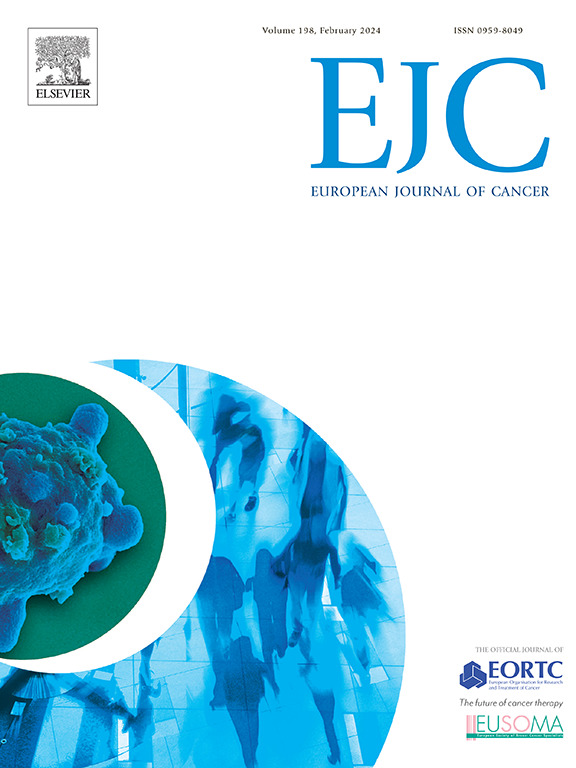BRAF V600E突变对接受免疫检查点抑制剂治疗的msi高转移性结直肠癌患者预后的影响
IF 7.1
1区 医学
Q1 ONCOLOGY
引用次数: 0
摘要
BRAF V600E突变对接受免疫检查点抑制剂(ICI)治疗的失配修复缺陷(dMMR)/微卫星不稳定性(MSI)转移性结直肠癌(mCRC)患者的预后影响尚不清楚。材料和方法这项回顾性国际研究纳入了2014年至2023年间接受ICI治疗的dMMR/MSI mCRC患者,以及可用的BRAF突变状态。结果在909例患者中,345例(38% %)患有BRAF V600E dMMR/MSI mCRC。在多变量分析中,与BRAFwt患者相比,BRAFm与ICI开始时较短的无进展生存期(PFS)和总生存期(OS)无关(中位PFS: 25.0 vs 41.5个月,调整风险比(adjHR)= 0.97,p = 0.8,OS: 55.1个月vs未达到adjHR= 0.98,p = 0.9)。然而,在一线接受ICI治疗的患者中,BRAFm患者的继发耐药率(定义为治疗前6个月后的进展)更高(20 % vs 11 %,p = 0.02)。在一线疾病控制6个月的患者中,BRAFm患者从这一点开始的PFS和OS显著缩短(PFS的adjHR为2.09,p = 0.03,OS的adjHR为2.80,p = 0.019)。在抗pd1和抗ctla4联合治疗的患者中不再观察到BRAF突变的不良预后价值。结论:在dMMR/MSI mCRC患者中,BRAF V600E突变与所有系总体人群中ICI治疗的PFS/OS缩短无关。然而,特别是在一线治疗的患者中,我们的结果表明BRAF突变与更高的继发耐药率相关,这表明PD1和CTLA4抑制剂的前期联合治疗可能对这些患者特别有意义。本文章由计算机程序翻译,如有差异,请以英文原文为准。
Prognostic impact of the BRAF V600E mutation in patients with MSI-high metastatic colorectal cancer treated with immune checkpoint inhibitors
Introduction
The prognostic impact of the BRAF V600E mutation in patients with deficient mismatch repair (dMMR)/microsatellite instability (MSI) metastatic colorectal cancer (mCRC) treated with immune checkpoint inhibitors (ICI) is poorly understood.
Material and methods
This retrospective international study included patients with dMMR/MSI mCRC treated with ICI all lines between 2014 and 2023, and available BRAF mutation status.
Results
Of 909 patients included, 345 (38 %) had BRAF V600E dMMR/MSI mCRC. In multivariable analysis, BRAFm was not associated with a shorter progression-free survival (PFS) and overall survival (OS) from ICI start compared to BRAFwt patients (median PFS: 25.0 vs 41.5 months, adjusted hazard ratio (adjHR)= 0.97, p = 0.8 and OS: 55.1 months vs not reached adjHR= 0.98, p = 0.9). However, in patients treated with ICI in first line, the rate of secondary resistance, defined as the progression after the first 6 months of treatment, was higher in BRAFm patients (20 % vs 11 %, p = 0.02). In patients with disease control for 6 months in 1st line, the PFS and OS from this point onwards were significantly shorter in BRAFm patients (adjHR for PFS 2.09, p = 0.03 and adjHR for OS 2.80, p = 0.019). The poor prognostic value of the BRAF mutation was no longer observed in patients treated with anti-PD1 and anti-CTLA4 combination.
Conclusions
In patients with dMMR/MSI mCRC, the BRAF V600E mutation is not associated with a shorter PFS/OS on ICI treatment in the overall population across all lines. However, specifically in patients treated in the first-line setting, our results suggest that the BRAF mutation is associated with a higher rate of secondary resistance, suggesting that a combination of PD1 and CTLA4 inhibitors upfront may be of particular interest in these patients.
求助全文
通过发布文献求助,成功后即可免费获取论文全文。
去求助
来源期刊

European Journal of Cancer
医学-肿瘤学
CiteScore
11.50
自引率
4.80%
发文量
953
审稿时长
23 days
期刊介绍:
The European Journal of Cancer (EJC) serves as a comprehensive platform integrating preclinical, digital, translational, and clinical research across the spectrum of cancer. From epidemiology, carcinogenesis, and biology to groundbreaking innovations in cancer treatment and patient care, the journal covers a wide array of topics. We publish original research, reviews, previews, editorial comments, and correspondence, fostering dialogue and advancement in the fight against cancer. Join us in our mission to drive progress and improve outcomes in cancer research and patient care.
 求助内容:
求助内容: 应助结果提醒方式:
应助结果提醒方式:


